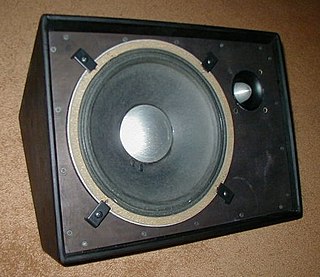
A loudspeaker is an electroacoustic transducer that converts an electrical audio signal into a corresponding sound. A speaker system, also often simply referred to as a "speaker" or "loudspeaker", comprises one or more such speaker drivers, an enclosure, and electrical connections possibly including a crossover network. The speaker driver can be viewed as a linear motor attached to a diaphragm which couples that motor's movement to motion of air, that is, sound. An audio signal, typically from a microphone, recording, or radio broadcast, is amplified electronically to a power level capable of driving that motor in order to reproduce the sound corresponding to the original unamplified electronic signal. This is thus the opposite function to the microphone; indeed the dynamic speaker driver, by far the most common type, is a linear motor in the same basic configuration as the dynamic microphone which uses such a motor in reverse, as a generator.

Binaural recording is a method of recording sound that uses two microphones, arranged with the intent to create a 3-D stereo sound sensation for the listener of actually being in the room with the performers or instruments. This effect is often created using a technique known as dummy head recording, wherein a mannequin head is fitted with a microphone in each ear. Binaural recording is intended for replay using headphones and will not translate properly over stereo speakers. This idea of a three-dimensional or "internal" form of sound has also translated into useful advancement of technology in many things such as stethoscopes creating "in-head" acoustics and IMAX movies being able to create a three-dimensional acoustic experience.
An audiophile is a person who is enthusiastic about high-fidelity sound reproduction. An audiophile seeks to reproduce the sound of a piece of recorded music or a live musical performance, typically inside closed headphones, In-ear monitors, open headphones in a quiet listening space, or a room with good acoustics.

Headphones are a pair of small loudspeaker drivers worn on or around the head over a user's ears. They are electroacoustic transducers, which convert an electrical signal to a corresponding sound. Headphones let a single user listen to an audio source privately, in contrast to a loudspeaker, which emits sound into the open air for anyone nearby to hear. Headphones are also known as earphones or, colloquially, cans. Circumaural and supra-aural headphones use a band over the top of the head to hold the speakers in place. Another type, known as earbuds or earpieces consist of individual units that plug into the user's ear canal. A third type are bone conduction headphones, which typically wrap around the back of the head and rest in front of the ear canal, leaving the ear canal open. In the context of telecommunication, a headset is a combination of headphone and microphone.
Noise-cancelling headphones reduce unwanted ambient sounds using active noise control. This is distinct from passive headphones which, if they reduce ambient sounds at all, use techniques such as soundproofing.

Active noise control (ANC), also known as noise cancellation (NC), or active noise reduction (ANR), is a method for reducing unwanted sound by the addition of a second sound specifically designed to cancel the first. The concept was first developed in the late 1930s; later developmental work that began in the 1950s eventually resulted in commercial airline headsets with the technology becoming available in the late 1980s. The technology is also used in road vehicles, mobile telephones, earbuds, and headphones.
Bone conduction is the conduction of sound to the inner ear primarily through the bones of the skull, allowing the hearer to perceive audio content without blocking the ear canal. Bone conduction transmission occurs constantly as sound waves vibrate bone, specifically the bones in the skull, although it is hard for the average individual to distinguish sound being conveyed through the bone as opposed to the sound being conveyed through the air via the ear canal. Intentional transmission of sound through bone can be used with individuals with normal hearing — as with bone-conduction headphones — or as a treatment option for certain types of hearing impairment. Bone generally conveys lower-frequency sounds better than higher frequency sounds.

A sound reinforcement system is the combination of microphones, signal processors, amplifiers, and loudspeakers in enclosures all controlled by a mixing console that makes live or pre-recorded sounds louder and may also distribute those sounds to a larger or more distant audience. In many situations, a sound reinforcement system is also used to enhance or alter the sound of the sources on the stage, typically by using electronic effects, such as reverb, as opposed to simply amplifying the sources unaltered.

An equal-loudness contour is a measure of sound pressure level, over the frequency spectrum, for which a listener perceives a constant loudness when presented with pure steady tones. The unit of measurement for loudness levels is the phon and is arrived at by reference to equal-loudness contours. By definition, two sine waves of differing frequencies are said to have equal-loudness level measured in phons if they are perceived as equally loud by the average young person without significant hearing impairment.

A headphone amplifier is a low-powered audio amplifier designed particularly to drive headphones worn on or in the ears, instead of loudspeakers in speaker enclosures. Most commonly, headphone amplifiers are found embedded in electronic devices that have a headphone jack, such as integrated amplifiers, portable music players, and televisions. However, standalone units are used, especially in audiophile markets and in professional audio applications, such as music studios. Headphone amplifiers are available in consumer-grade models used by hi-fi enthusiasts and audiophiles and professional audio models, which are used in recording studios.
In acoustics, the dummy head recording is a method of recording used to generate binaural recordings. The tracks are then listened to through headphones allowing for the listener to hear from the dummy’s perspective. The dummy head is designed to record multiple sounds at the same time enabling it to be exceptional at recording music as well as in other industries where multiple sound sources are involved.

Sony MDR-V6 is a large diaphragm folding pair of headphones, the initial entry in Sony's Studio Monitor headphones, one of the most popular model lines among professional audio engineers. The product line was augmented by the MDR-V600, the MDR-7506 and then the MDR-7509 and MDR-7509HD models, which continue to be popular for audio editing, live sound and broadcast applications. The four models use a closed, circumaural sealed-ear design with a coiled oxygen-free copper cord, tipped with a combination ¼″ (6.35 mm) and ⅛″ mini (3.5 mm) TRS phone connector. As a product line, the MDR-series Studio Monitor folding headphones have been noted as a "favorite of sound professionals because they're reasonably flat sounding, inexpensive, compact, and they can take a lot of punishment." The MDR prefix is an initialism of the Micro Dynamic Receiver trademark.
The Air Motion Transformer (AMT) is a type of electroacoustic transducer. Invented by Oskar Heil (1908–1994), it operates on a different transduction principle from other loudspeaker designs, such as moving coil, planar magnetic or electrostatically-driven loudspeakers, and should not be confused with planar or true ribbon loudspeakers. In contrast to a planar ribbon loudspeaker, the diaphragm of the AMT is of pleated shape similar to a bellows. The AMT moves air laterally in a perpendicular motion using a metal-etched folded sheet made of polyethylene terephthalate (PET) film. The circuit path embossed on the PET membrane, acts as the voice coil unit. The diaphragm is then housed between 4 stacks of steel pole-plate pieces positioned at 45° within a high-intensity, quadratic, opposing magnetic field. The air motion transformer with its sheet film equally exposed at 180° behaves as a dipole speaker, exciting front and rear sonic waves simultaneously.

AKG Acoustics is an acoustics engineering and manufacturing company. It was founded in 1947 by Rudolf Görike and Ernest Plass in Vienna, Austria. It is a part of Harman International Industries, a subsidiary of Samsung Electronics.

The moving iron speaker was the earliest type of electric loudspeaker. They are still used today in some miniature speakers where small size and low cost are more important than sound quality. A moving iron speaker consists of a ferrous-metal diaphragm or reed, a permanent magnet and a coil of insulated wire. The coil is wound around the permanent magnet to form a solenoid. When an audio signal is applied to the coil, the strength of the magnetic field varies, and the springy diaphragm or reed moves in response to the varying force on it. The moving iron loudspeaker Bell telephone receiver was of this form. Large units had a paper cone attached to a ferrous metal reed.

A stage monitor system is a set of performer-facing loudspeakers called monitor speakers, stage monitors, floor monitors, wedges, or foldbacks on stage during live music performances in which a sound reinforcement system is used to amplify a performance for the audience. The monitor system allows musicians to hear themselves and fellow band members clearly.
HiFiMAN Electronics is a Chinese manufacturer of audio products including headphones, amplifiers, and portable audio players. Hifiman is known for its high-end audio products, initially made under the brand Head-Direct but now only as HIFIMAN.

AirPods Max are wireless Bluetooth over-ear headphones designed by Apple, and released on December 15, 2020. They are Apple’s highest-end option in the AirPods lineup, sold alongside the base model AirPods and mid-range AirPods Pro.












